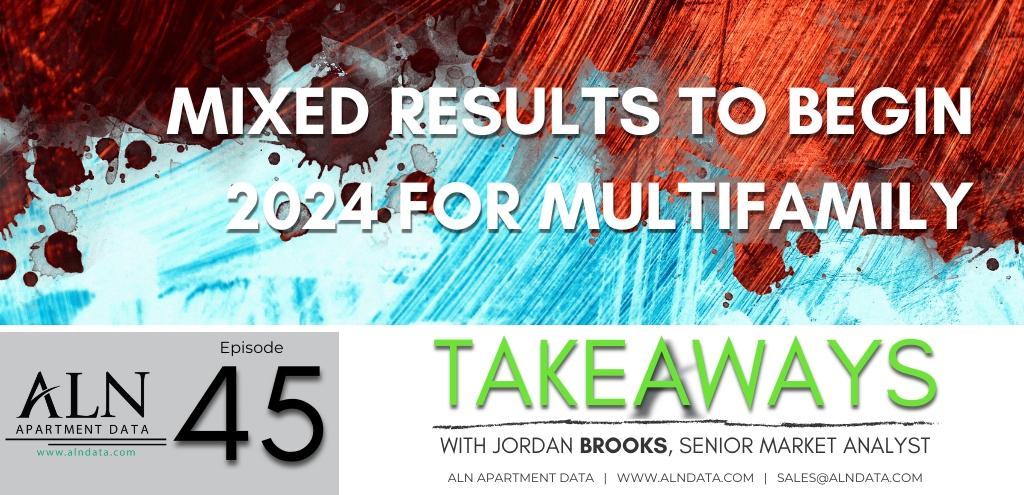Continued Demand Improvement in Q1
Apartment demand has been steadily improving since bottoming out in 2022, and the opening quarter of 2024 was another step in the right direction. This month’s upcoming ALN newsletter will feature a broader look at the first quarter and its implications for multifamily performance this year, but for now, let’s zoom in on the demand picture.
All numbers will refer to conventional properties of at least 50 units.
Incremental Improvement
Apartment demand has not surged back from the depths of 2022. Rather, the last year or so has featured a succession of moderate steps toward a typical level of net absorption. Approximately 47,000 net units were absorbed in Q1 2024. The result compared favorably both to the net loss of about 800 leased units nationally in the final quarter of 2023 and the roughly 16,000 net absorbed units in the opening quarter of last year.
Not only has net absorption in each of the last four quarters been higher than the corresponding period of the prior year, but the monthly data provide some reason for optimism as well. Usual seasonal trends in multifamily demand, which were largely absent in the 2020 through 2022 period, so far seem to have fully reemerged. Net absorption usually begins the year still in the midst of winter doldrums and then begins to improve around March. That has been the case this year. But, the month-over-month growth in demand has been robust. Monthly net absorption totals have nearly doubled the previous month in each of the first three months of 2024.
However, despite the improvement, apartment demand remains below the longer-term average. Remove the outlier year of 2021, and average national net absorption across the last five first quarters was about 59,000 units. This year’s total was 20% lower than that five-year average. Where that leaves national apartment demand heading into the traditionally stronger part of the calendar is in the midst of a positive upward trend but with ground still to be made up.

In our series Takeaways, ALN Apartment Data Senior Market Analyst, Jordan Brooks, shares more insight into the final thoughts on the April 2024 newsletter article…
Class A Struggled in Q1
Net absorption in the first quarter surpassed last year’s total, but not due to the Class A segment. Approximately 12,000 net absorbed units in the period fell short of last year’s 15,000-unit total and was only roughly half of the Q1 2022 value. Of the 12,000 net absorbed units, less than 100 units were from properties that entered the year already stabilized.
The Class B subset managed to gain ground in the first quarter, with just over 21,000 net absorbed units representing the best result for the period since 2021. The more dramatic improvement occurred in the workforce housing segments, though.
Class C net absorption of around 13,000 units marked a stark upward shift from a net loss of nearly 1,000 leased units in the opening three months of 2023 and narrowly bettered the 2022 total as well. For Class D, only approximately 1,200 net units were absorbed in the first quarter, but this followed two straight years with a net loss of leased units in the opening quarter. This year’s positive total came after last year’s net loss of more than 11,000 leased units in the period.
Takeaways
Challenges remain for the multifamily industry this year, but there is some reason for optimism when it comes to apartment demand. Overall net absorption remains somewhat lower than had been typical pre-pandemic, but consistent positive momentum has now been building for more than a year.
Of particular note in the first quarter data was the encouraging movement within the Class C and Class D market segments. These price tiers have struggled mightily the last couple of years, and those struggles played a major role in the shortfall in net absorption for that period. If the tide were to continue to turn in 2024, it would go a long way toward returning annual multifamily demand to its usual range from recent years after two years of falling well short of that range.
Disclaimer: All content and information within this article is for informational purposes only. ALN Apartment Data makes no representation as to the accuracy or completeness of any information in this or any other article posted on this site or found by following any link on this site. The owner will not be held liable for any losses, injuries, or damages from the display or use of this information. All content and information in this article may be shared provided a link to the article or website is included in the shared content.

